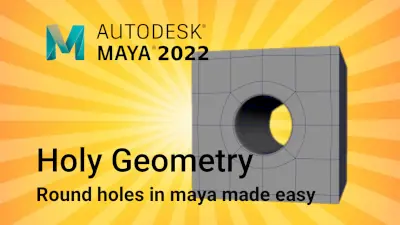Complex UV Layout in Maya
Over the last couple of years UV layout in Maya has changed for the better. In this course we're going to be taking a look at some of those changes as we UV map an entire character
#
1
23-05-2014
, 10:22 AM
Registered User
Join Date: May 2014
Join Date: May 2014
Location: Seoul, Korea
Posts: 3
about Eval
I'm and the Eval Command part where the sample code reads as follows;
global proc calc (string $statement)
{
float $res = eval("float + $_dummy = " + $statement);
print ("\n" +$statement +"=" +$res);
}
calc("1+2");
calc("10*2/5");
results shows '1+2=3' and '10 *2/5 = 4'
what I don't get here is how these results show up.
I get the basic fact the eval command allows you to execute things in string form.
what I really don't get is this part ;
eval("float + $_dummy = " + $statement);
print ("\n" +$statement +"=" +$res);
I have no idea how this works to show both the equation and its result.
can any of you help me?
#
2
23-05-2014
, 10:49 AM
EduSciVis-er
Join Date: Dec 2005
Join Date: Dec 2005
Location: Toronto
Posts: 3,374
#
3
23-05-2014
, 11:03 AM
Registered User
Join Date: May 2014
Join Date: May 2014
Location: Seoul, Korea
Posts: 3
so when calc is called the ("1+2"); for example is sent into the $statement function
but what does the rest of the script like "float + $_dummy = " part have to do with showing
1+3=4 result?
#
4
23-05-2014
, 04:36 PM
You first call calc with an argument:
Code:
calc("1+2");
Code:
global proc calc ("1+2")
{
float $res = eval("float $_dummy = " + "1 + 2");
print ("\n" +$statement +"=" +$res);
}
Code:
global proc calc ("1+2")
{
float $res = eval("float $_dummy = 1 + 2");
print ("\n" +$statement +"=" +$res);
}
Code:
global proc calc ("1+2")
{
float $_dummy = 1 + 2;
float $res = $_dummy;
print ("\n" +$statement +"=" +$res);
}
Imagination is more important than knowledge.
#
5
25-05-2014
, 10:26 AM
Registered User
Join Date: May 2014
Join Date: May 2014
Location: Seoul, Korea
Posts: 3

Posting Rules Forum Rules
Topics
Free Courses
Full Courses
VFX News
How computer animation was used 30 years ago to make a Roger Rabbit short
On 2022-07-18 14:30:13
Sneak peek at Houdini 19.5
On 2022-07-18 14:17:59
VFX Breakdown The Man Who Fell To Earth
On 2022-07-15 13:14:36
Resident Evil - Teaser Trailer
On 2022-05-13 13:52:25
New cloud modeling nodes for Bifrost
On 2022-05-02 20:24:13
MPC Showreel 2022
On 2022-04-13 16:02:13








